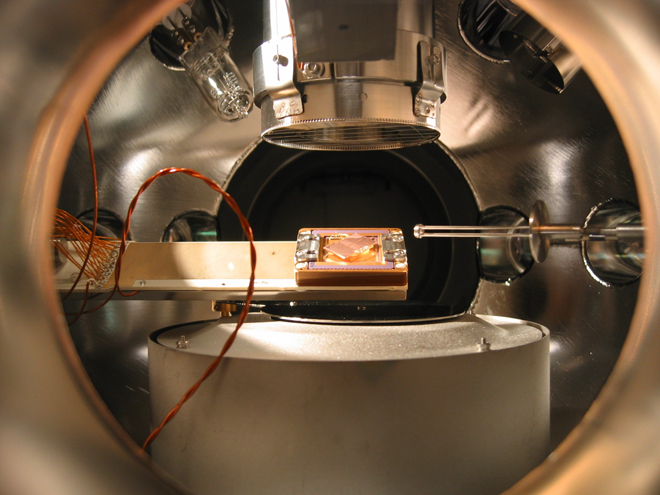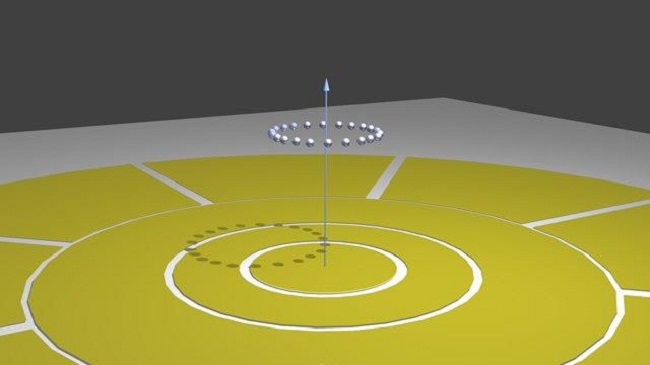Physicists have created the world's first "crystal of time"

Chris Monroe worked with an ion trap of a similar construction (source: Hartmut Häffner)
In 2012, Nobel Prize in Physics, Frank Vilchek, proposed an unusual idea. He suggested (and tried to prove) the possibility of the existence of "time crystals". Such structures, according to the physicist, receive energy for their movement from a fault in time symmetry. The fault, according to Wilczek, is a particular form of perpetual motion.
The crystals themselves are very unusual structures. For example, crystals (of which those whose crystal lattice does not have the highest — cubic — symmetry) are inherent in the anisotropy property. Anisotropy of crystals is the heterogeneity of their physical properties (elastic, mechanical, thermal, electrical, magnetic, optical, etc.) in various directions.
Modern physicists are interested not only in the anisotropy of crystals, but also in their symmetry. As for symmetry, it manifests itself not only in their structure and properties in real three-dimensional space, but also in describing the energy spectrum of crystal electrons, analyzing X-ray diffraction, neutron diffraction and electron diffraction in crystals using inverse space, etc. As for the "crystals of time", here scientists have suggested that the crystals are symmetrical in time.
')
Wilchek talked about this possible phenomenon back in 2010: “I was constantly thinking about the classification of crystals, and then I thought that you can imagine space-time from this point of view. That is, if we think about crystals in space, it will be logical to represent crystal structures in time. ” In crystals, atoms occupy a stable position in the lattice. And since stable objects remain unchanged in time, there is a possibility that atoms can form a constantly repeating grid in time. They return to their original position through a discrete interval, breaking the time symmetry. If the crystal does not consume and does not produce energy, then such temporary crystals are stable, being in the “ground state”. In this case, cyclic changes occur in the structure of the crystal, which, from the point of view of physics, can be considered an eternal motion.
Many physicists had doubts about the validity of the hypothesis of the possibility of the existence of temporary crystals. But those scientists who accepted it, began to look for ways to check the validity of Vilcek's assumption. And found.

Chris Monroe of the University of Maryland at College Park was the first to create a temporary crystal in his laboratory. His idea was to create a quantum system in the form of a group of ions arranged in a ring. When cooling the ring, as stated by Monroe (and before it other scientists), the energy state of the entire system will drop to the minimum level. In other words, in such conditions, the system enters the phase of the “ground state”. If the temporal symmetry is broken, then the ring should change in time. In other words, rotate. Of course, it is impossible to extract the energy of this movement, since it contradicts the law of conservation of energy.

All this is a theory. In practice, this idea is more difficult to implement. The intention to create a ring of ions and verify the validity of the hypothesis of temporary crystals a few years ago, scientists from Berkeley reported. They planned to inject hundreds of calcium ions into a small cell. This camera needs to be surrounded by electrodes and turn on the current. The resulting electric field allows you to drive ions into the chamber with a thickness of about 100 microns. After that, it is necessary to “calibrate” particles to level the field. Ions, pushing away from each other, would form a crystal ring, being distributed evenly along the outer edge of the chamber.
It is assumed that the ions in such a trap will be in an excited state, but with the help of a laser their kinetic energy will be gradually reduced. According to the plan, the temperature of the system must be brought to 1 billionth degree above zero. After the system reaches the ground state, the scientists planned to turn on a static magnetic field. This field, if the hypothesis of temporal crystals is correct, should have caused the ions to rotate. After the ions return to the starting point within a certain time period, scientists would record a violation of the time symmetry.
Monroe went the same way, only to create a ring, he did not use potassium ions, but ytterbium ions. The difficulty in implementing the idea is that it is not possible to predict the existence of a particle at a certain time in a certain place. However, thanks to the Anderson localization, an exception appears in this rule, which can be used. Anderson localization is a phenomenon that occurs when waves propagate in a medium with spatial inhomogeneities and that due to multiple scattering on inhomogeneities and interference of scattered waves, the propagation of traveling waves becomes impossible; Oscillations acquire the character of a standing wave, concentrated (localized) in a limited region of space.
Relatively recently, physicists have studied groups of quantum particles that interact with each other in such a way that this interaction forces them to localize. Monroe was able to use the results of this study in order to force the ytterbium ions to take certain places at certain times. As a result, a time crystal was created, and the Monroe team thus proved the possibility of a time symmetry breaking. When studying the properties of a temporary crystal, it turned out that a significant change in the frequency of ion excitation causes the crystal to "melt". According to scientists, the creation of a temporary crystal opens up broad opportunities for quantum computing. For example, based on time crystals, you can create a reliable quantum memory.
True, the work of Monroe and colleagues still requires verification. Other teams of physicists plan to verify the nature of the effect of temporary crystals by repeating the experiment. If this succeeds, then the Frank Wilczek hypothesis will become a theory, and quantum physics will receive an incentive for further development.
arXiv: 1609.08684
Source: https://habr.com/ru/post/398169/
All Articles